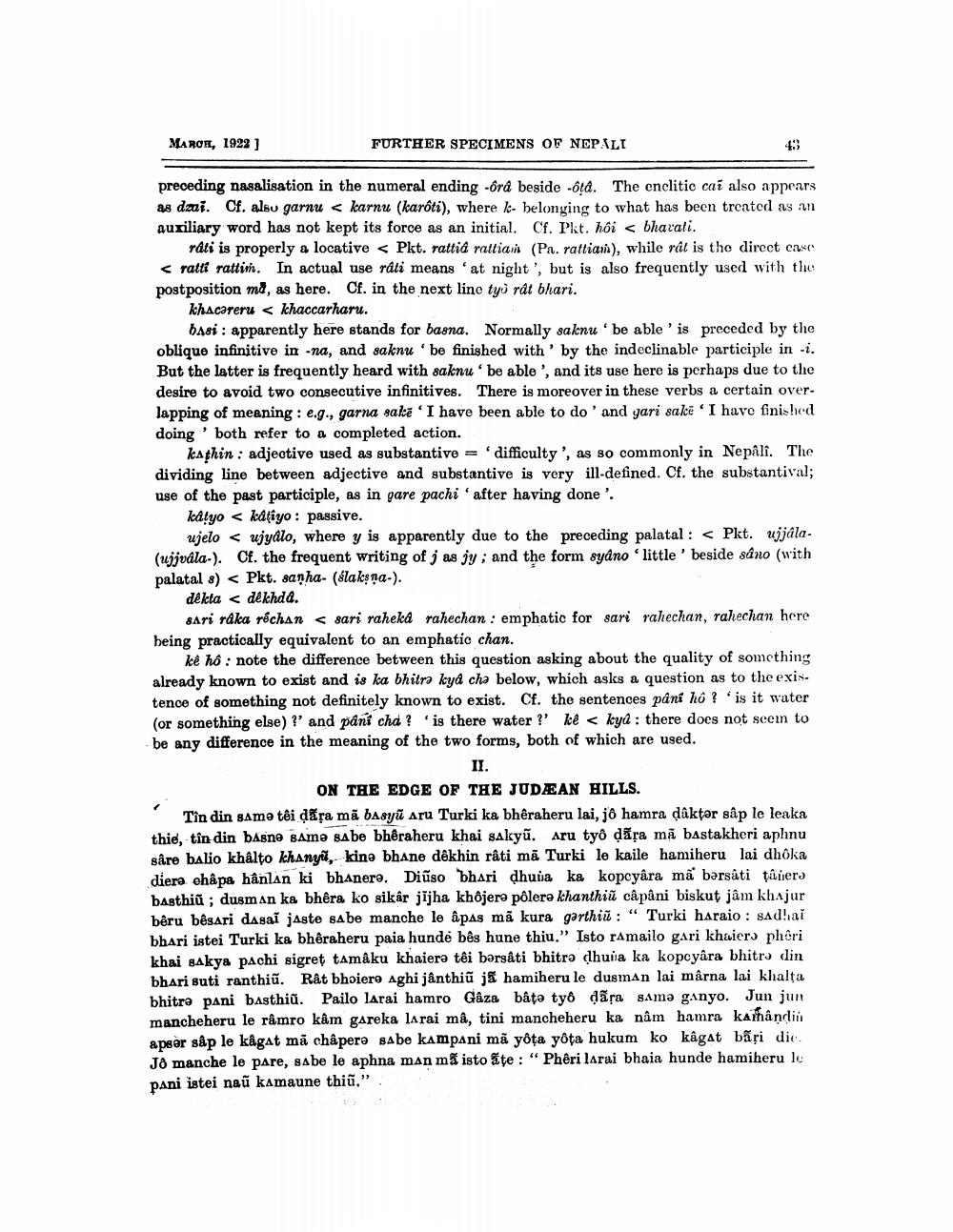________________
MAROE, 1922)
FURTHER SPECIMENS OF NEPALI
preceding nasalisation in the numeral ending -rd beside -ota. The enclitic cai also appears as daai. Cf. alsu garnu < karnu (karôti), where I belonging to what has been treated as an auxiliary word has not kept its force as an initial. Cf. Pkt. hôi < bharali.
rati is properly a locative < Pkt. rattia rattian (Pa. rattia), while ral is the direct case < ratti rattin. In actual use rati means 'at night', but is also frequently used with the postposition me, as here. Cf. in the next line työ rdt bhari.
khacareru < khaccarharu.
basi : apparently here stands for barna. Normally saknu be able 'is preceded by the oblique infinitive in -na, and saknu 'be finished with' by the indeclinable participle in -i. But the latter is frequently heard with saknu' be able ', and its use here is perhaps due to the desire to avoid two consecutive infinitives. There is moreover in these verbs a certain overlapping of meaning : e.g., garna sakė 'I have been able to do and yari sake I have finished doing 'both refer to a completed action.
kathin : adjective used as substantive = 'difficulty', as so commonly in Nepali. The dividing line between adjective and substantive is very ill-defined. Cf. the substantival; use of the past participle, as in gare pachi ' after having done'.
katyo katiyo: passive.
ujelo < ujyalo, where y is apparently due to the preceding palatal : < Pkt. ujjála(ujjvála-). Cf. the frequent writing of j as jy; and the form syano 'little 'beside sâno (with palatal 8) < Pkt. sanha- (Slaksna-).
dékta < dekhda.
sari raka réchan s sari raheka rahechan: emphatic for sari rahechan, rahechan here being practically equivalent to an emphatic chan.
ke hô: note the difference between this question asking about the quality of something already known to exist and is ka bhitra kya cha below, which asks a question as to the exis. tence of something not definitely known to exist. Cf. the sentences pâní ho ? is it water (or something else) ?' and pani cha? is there water ?' ke < kya : there does not seem to be any difference in the meaning of the two forms, both of which are used.
II.
ON THE EDGE OF THE JUDÆAN HILLS. Tin din same têi dara mã basyữ Aru Turki ka bhêraheru lai, jo hamra daktər sâp le leaka thie, tin din basno samo sabe bhêraheru khai sakyū. Aru tyo dara mã bastakheri aphnu sâre balio khâlto khanya, kine bhane dekhin râti mã Turki le kaile hamiheru lai dhoka diera châpa hânlan ki bhanero. Diūso bhari dhuia ka kopoyâra mă bersati tallers basthiū ; dusman ka bhêra ko sikar jijha khôjere pôlere khanthiữ câpâni biskut jâm khajur bêru bêsari dagai jaste sabe manche le âpas mã kura garthiū : " Turki haraio: sad!ai bhari istei Turki ka bhêraheru paia hunde bês hune thiu." Isto ramailo gari khaiers phêri khai sakya pachi sigret tamâku khaiera têi bərsâti bhitrə dhuia ka kopcyâra bhitra din bhari suti ranthiū. Rât bhoiero Aghi jânthiū j& hamiheru le dusman lai mârna lai khalta bhitra pani basthių. Pailo larai hamro Gâza bâțo ty8 dara samə ganyo. Jun jun mancheheru le ramro kam gareka larai mâ, tini mancheheru ka nam hamra kamândii apgor såp le kågat mã chåpero sabe kampani mã yota yota hukum ko kâgat bãri dic. Jo manche le pare, sabe le aphna man mă isto šte: "Phêri larai bhaia hunde hamiheru le pani istei naū kamaune thiū." ;




